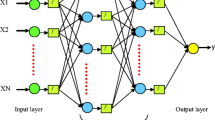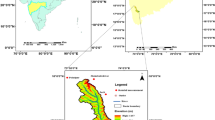Abstract
Successful modeling of stochastic hydro-environmental processes widely relies on quantity and quality of accessible data and noisy data might effect on the functioning of the modeling. On the other hand in training phase of any Artificial Intelligence based model, each training data set is usually a limited sample of possible patterns of the process and hence, might not show the behavior of whole population. Accordingly in the present article first, wavelet-based denoising method was used in order to smooth hydrological time series and then small normally distributed noises with the mean of zero and various standard deviations were generated and added to the smoothed time series to form different denoised-jittered training data sets, for Artificial Neural Network (ANN) and Adaptive Neuro-Fuzzy Inference System (ANFIS) modeling of daily and multi-step-ahead rainfall–runoff process of the Milledgeville station of the Oconee River and the Pole Saheb station of the Jighatu River watersheds, respectively located in USA and Iran. The proposed hybrid data pre-processing approach in the present study is used for the first time in modeling of time series and especially in modeling of hydrological processes. Furthermore, the impacts of denoising (smoothing) and noise injection (jittering) have been simultaneously investigated neither in hydrology nor in any other engineering fields. To evaluate the modeling performance, the outcomes were compared with the results of multi linear regression and Auto Regressive Integrated Moving Average models. Comparing the achieved results via the trained ANN and ANFIS models using denoised-jittered data showed that the proposed data pre-processing approach which serves both denoising and jittering techniques could improve performance of the ANN and ANFIS based single-step-ahead rainfall–runoff modeling of the Milledgeville station up to 14 and 12% and of the Pole Saheb station up to 22 and 16% in the verification phase. Also the results of multi-step-ahead modeling using the proposed data pre-processing approach showed improvement of modeling for both watersheds.






Similar content being viewed by others
References
Abrahart RJ, See L (2000) Comparing neural network (NN) and auto regressive moving average (ARMA) techniques for the provision of continuous river flow forecasts in two contrasting catchments. Hydrol Process 14:2157–2172
Abrahart RJ, Anctil F, Coulibaly P, Dawson CW, Mount NJ, See LM, Shamseldin AY, Solomatine DP, Toth E, Wilby RL (2012) Two decades of anarchy? Emerging themes and outstanding challenges for neural network river forecasting. Prog Phys Geogr 36:480–513
Adamowski J, Chan HF, Prasher SO, Ozga-Zielinski B, Sliusarieva A (2012) Comparison of multiple linear and nonlinear regression, autoregressive integrated moving average, artificial neural network, and wavelet artificial neural network methods for urban water demand forecasting in Montreal, Canada. Water Resour Res 48:W01528
Aqil M, Kita I, Yano A, Nishiyama S (2007) Analysis and prediction of flow from local source in a river basin using a Neuro-fuzzy modeling tool. J Environ Manag 85:215–223
ASCE task Committee on Application of Artificial Neural Networks in hydrology (2000) Artificial Neural Networks in hydrology 2: hydrologic applications. J Hydrol Eng 5(2):124–137
Bowker AH, Lieberman GJ (1972) Engineering statistics. Prentice-Hall, New Jersey
Chen L, Singh VP, Guo S, Zhou J, Ye L (2014) Copula entropy coupled with artificial neural network for rainfall–runoff simulation. Stoch Environ Res Risk Assess 28(7):1755–1767
Chen XY, Chau KW, Busari AO (2015a) A comparative study of population-based optimization algorithms for downstream river flow forecasting by a hybrid neural network model. Eng Appl Artif Intell 46:258–268
Chen XY, Chau KW, Wang WC (2015b) A novel hybrid neural network based on continuity equation and fuzzy pattern-recognition for downstream daily river discharge forecasting. J Hydroinform 17(5):733–744
Chen J, Shi HY, Sivakumar B, Peart MR (2016) Population, water, food, energy and dams. Renew Sustain Energy Rev 56:18–28
Chou CM (2014) Complexity analysis of rainfall and runoff time series based on sample entropy in different temporal scales. Stoch Environ Res Risk Assess 28(6):1401–1408
Cleaveland MK, Stahle DW (1989) Tree ring analysis of surplus and deficit runoff in the White River, Arkansas. Water Resour Res 25(6):1391–1401
Danandeh Mehr A, Kahya E, Şahin A, Nazemosadat MJ (2015) Successive-station monthly streamflow prediction using different ANN algorithms. Int J Environ Sci Technol 12(7):2191–2200
Donoho DL (1995) Denoising by soft-thresholding. IEEE Trans Inf Theory 41(3):613–617
Donoho DL, Johnstone IM (1995) Ideal spatial adaptation via wavelet shrinkage. Biometrik 81(3):425–455
Gautam DK, Holz KP (2001) Rainfall–runoff modeling using adaptive neuro fuzzy systems. J Hydroinform 3(1):3–10
Hansen JV, Nelson RD (1997) Neural networks and traditional time series methods: a synergistic combination in state economic forecasts. IEEE Trans Neural Netw 8(4):863–873
Hornik K (1988) Multilayer feed-forward networks are universal approximators. Neural Netw 2(5):359–366
Jang JSR, Sun CT (1995) Neuro-fuzzy modeling and control. Proc IEEE 83:378–406
Jang JSR, Sun CT, Mizutani E (1997) Neuro-fuzzy and soft computing: a computational approach to learning and machine intelligence, 3rd edn. Prentice-Hall, New Jersey
Jansen M (2006) Minimum risk thresholds for data with heavy noise. IEEE Signal Process Lett 13:296–299
Jothiprakash V, Magar RB, Kalkutki S (2009) Rainfall–runoff models using adaptive neuro-fuzzy inference system (ANFIS) for an intermittent rive. Int J Artif Intell 3:1–23
Kalman RE (1960) A new approach to linear filtering and prediction problems. J Basic Eng T ASME 82(1):35–45
Kan G, Yao C, Li Q, Li Z, Yu Z, Liu Z, Ding L, He X, Liang K (2015) Improving event-based rainfall–runoff simulation using an ensemble artificial neural network based hybrid data-driven model. Stoch Environ Res Risk Assess 29(5):1345–1370
Kim T, Valdes JB (2003) Nonlinear model for drought forecasting based on a conjunction of wavelet transforms and neural networks. J Hydrol Eng 8(6):319–328
Liu KL, Li ZJ, Yao C, Chen J, Zhang K, Saifullah M (2016) Coupling the k-nearest neighbor procedure with the Kalman filter for real-time updating of the hydraulic model in flood forecasting. Int J Sediment Res 31(2):149–158
Ly S, Charles C, Degré A (2013) Different methods for spatial interpolation of rainfall data for operational hydrology and hydrological modeling at watershed scale. A review. Biotechnol Agron Soc Environ 17:392–406
Martyn PC, David ER, Ross AW, Xiaogu Z, Richard PI, Andrew GS, Jochen S, Michael JU (2008) Hydrological data assimilation with the ensemble Kalman filter: use of streamflow observations to update states in a distributed hydrological model. Adv Water Resour 31:1309–1324
Nayak PC, Sudheer KP, Rangan DM, Ramasastri KS (2004) A neuro-fuzzy computing technique for modeling hydrological time series. J Hydrol 29:52–66
Nejad FH, Nourani V (2012) Elevation of wavelet denoising performance via an ANN-based streamflow forecasting model. Int J Comput Sci Manag Res 1(4):764–770
Nourani V, Mano A (2007) Semi-distributed flood runoff model at the sub-continental scale for southwestern Iran. Hydrol Process 21:3173–3180
Nourani V, Parhizkar M (2013) Conjunction of SOM-based feature extraction method and hybrid wavelet-ANN approach for rainfall–runoff modeling. J Hydroinform 15(3):829–848
Nourani V, Saeidifarzad B (2016) Detection of land use/cover change effect on watershed’s response in generating runoff using computational intelligence approaches. Stoch Environ Res Risk Assess. doi:10.1007/s00477-016-1220-z
Nourani V, Mogaddam AA, Nadiri AO (2008) An ANN based model for spatiotemporal groundwater level forecasting. Hydrol Process 22:5054–5066
Nourani V, Komasi M, Mano A (2009) A multivariate ANN-wavelet approach for rainfall–runoff modeling. Water Resour Manage 23:2877–2894
Nourani V, Kisi Ö, Komasi M (2011) Two hybrid artificial intelligence approaches for modeling rainfall–runoff process. J Hydrol 402:41–59
Nourani V, HosseiniBaghanam A, Adamowski J, Gebremichael M (2013) Using self-organizing maps and wavelet transforms for space–time pre-processing of satellite precipitation and runoff data in neural network based rainfall–runoff modeling. J Hydrol 476:228–243
Nourani V, Baghanam AH, Rahimi AY, Nejad FH (2014) Evaluation of wavelet-based de-noising approach in hydrological models linked to artificial neural networks. In: Islam T, Srivastava PK, Gupta M, Mukherjee S, Zhu X (eds) Artificial intelligence techniques in earth and environmental science. Springer, Berlin, pp 209–241
Ooyen AV, Nienhuis B (1992) Improving the convergence of the back propagation algorithm. Neural Netw 5(3):465–471
Pulido-Calvo I, Portela MM (2007) Application of neural approaches to one-step daily flow forecasting in Portuguese watersheds. J Hydrol 332:1–15
Rajurkar MP, Kothyari UC, Chaube UC (2002) Artificial neural networks for daily rainfall–runoff modeling. Hydrol Sci J 47(6):865–877
Reed R, Marks RJ II, Oh S (1995) Similarities of error regularization, sigmoid gain scaling, target smoothing, and training with jitter. IEEE Trans Neural Netw 6(3):529–538
Reichel RH, Walker JP, Koster RD, Houser PR (2002) Extended versus ensemble Kalman filtering for land data assimilation. J Hydrometeorol 3:728–740
Salas JD, Delleur JW, Yevjevich V, Lane WL (1980) Applied modeling of hydrological time series, 1st edn. Water Resources Publications, Littleton
Sang YF (2013) A review on the applications of wavelet transform in hydrology time series analysis. Atmos Res 122:8–15
Sang YF, Wang D, Wu JC, Zhu QP, Wang L (2009a) Entropy-based wavelet de-noising method for time series analysis. Entropy 11:1123–1147
Sang YF, Wang D, Wu JC, Zhu QP, Wang L (2009b) The relationship between period’s identification and noises in hydrological series data. J Hydrol 368:165–177
Sen Z (1998) Average areal precipitation by percentage weighted polygon method. J Hydrol Eng 3(1):69–72
Shi HY, Fu XD, Chen J, Wang GQ, Li TJ (2014) Spatial distribution of monthly potential evaporation over mountainous regions: case of the Lhasa River basin, China. Hydrol Sci J 59(10):1856–1871
Shi HY, Li TJ, Liu RH, Chen J, Li JY, Zhang A, Wang GQ (2015) A service-oriented architecture for ensemble flood forecast from numerical weather prediction. J Hydrol 527:933–942
Silva A, Gonçalves T (2013). Training support vector machines with a heterogeneous particle swarm optimizer. In: Adaptive and natural computing algorithms, volume 7824 of the series Lecture Notes in Computer Science, pp 100–109
Singh S (1999) Noise impact on time-series forecasting using an intelligent pattern matching technique. Pattern Recogn 32:1389–1398
Singh S (2000) Noise time-series prediction using pattern recognition techniques. Comput Intell 16(1):114–133
Snedecor GW, Cochran WG (1981) Statistical methods, 7th edn. Iowa State University Press, Iowa
Szcześniak M, Piniewski M (2015) Improvement of hydrological simulations by applying daily precipitation interpolation schemes in meso-scale catchments. Water 7:747–779
Taormina R, Chau KW (2015) Data-driven input variable selection for rainfall–runoff modeling using binary-coded particle swarm optimization and extreme learning machines. J Hydrol 529:1617–1632
Tayfur G, Singh VP (2006) ANN and fuzzy logic models for simulating event-based rainfall–runoff. J Hydraul Eng 132(12):1321–1330
Tongal H, Berndtsson R (2016) Impact of complexity on daily and multi-step forecasting of streamflow with chaotic, stochastic, and black-box models. Stoch Environ Res Risk Assess. doi:10.1007/s00477-016-1236-4
Walker JS (1999) A primer on wavelets and their scientific applications. Chapman and Hall, New York
Wang WCH, Chau KW, Xu DM, Chen XY (2015) Improving forecasting accuracy of annual runoff time series using ARIMA based on EEMD decomposition. Water Resour Manag 29:2655–2675
Wiener N (1949) Extrapolation, interpolation, and smoothing of stationary time series. Wiley, New York
Zhang GP (2003) Time series forecasting using a hybrid ARIMA and neural network model. Neurocomputing 50:159–175
Zhang GP (2007) A neural network ensemble method with jittered training data for time series forecasting. Inf Sci 177:5329–5346
Zhang Q, Wang BD, He B, Peng Y, Ren ML (2011) Singular spectrum analysis and ARIMA hybrid model for annual runoff forecasting. Water Resour Manag 25:2683–2703
Zhang A, Li TJ, Si Y, Liu RH, Shi HY, Li X, Li JY, Wu X (2016) Double-layer parallelization for hydrological model calibration on HPC systems. J Hydrol 535:737–747
Zur RM, Jiang Y, Metz CE (2004) Comparison of two methods of adding jitter to artificial neural network training. Int Congr Ser 1268:886–889
Author information
Authors and Affiliations
Corresponding author
Rights and permissions
About this article
Cite this article
Nourani, V., Partoviyan, A. Hybrid denoising-jittering data pre-processing approach to enhance multi-step-ahead rainfall–runoff modeling. Stoch Environ Res Risk Assess 32, 545–562 (2018). https://doi.org/10.1007/s00477-017-1400-5
Published:
Issue Date:
DOI: https://doi.org/10.1007/s00477-017-1400-5




